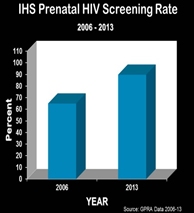HIV/AIDS

ISSUE
American Indians and Alaska Natives (AI/AN) experience a higher rate of new infections of human immunodeficiency virus (HIV) when compared with White and Asian/Pacific Islander populations. HIV/ Acquired Immune Deficiency Syndrome (AIDS) is communicable and has no cure or vaccine, although new therapies are continually emerging that, when adhered to, extend the quality and length of life and reduce the spread of infection. Strong prevention strategies are being developed and adapted in AI/AN communities to help people living with HIV/AIDS lead full lives.
BACKGROUND
The Indian Health Service (IHS) HIV/AIDS Program is a culturally-fluent effort based upon a comprehensive public health approach. IHS focuses on effective prevention to reduce the impact of HIV/AIDS in AI/AN communities. This includes offering expanded HIV screening regardless of perceived risk factors, spreading prevention messages, and supporting behavioral changes. In addition, IHS has developed its capacity to treat HIV/AIDS through measures such as increasing access to infectious disease providers and pharmacists throughout the IHS system.
STATUS
American Indian and Alaska Native people living with AIDS are known to have one of the shortest timelines from AIDS diagnosis to death. Because HIV/AIDS can be asymptomatic for long periods of time, screening plays an important role in early diagnosis and entry to treatment. Over the last 8 years, IHS HIV screening rates have more than tripled and the prenatal HIV screening rate has risen from 65 percent to 89.8 percent IHS-wide.
Factors that contribute to elevated HIV/AIDS rates among AI/ANs include disproportionate rates of sexually transmitted infections (AI/ANs have the second-highest rates of gonorrhea, chlamydia, and syphilis combined in the U.S.); alcohol and substance abuse; depression; sexual and domestic violence; high incarceration rates; and low socioeconomic status. Other factors include a greater proportion of young adults (as compared to other social groups), social and cultural stigma attached to the disease, and discrimination. It is also known that AI/AN youth are only half as likely to use contraceptives as their non-Native peers, thereby further increasing the risk of acquiring or spreading HIV.
OPTIONS/PLANS
The IHS HIV/AIDS Program goals include ensuring access to quality health care services for those at risk and those living with HIV, increasing individual awareness of personal HIV serostatus, increasing HIV testing, addressing social stigma and discrimination, implementing best practices, and continuing to provide and expand quality care. The Program continues to grow and implement new initiatives each year, including tribal policy projects, national screening initiatives, telehealth projects, and HIV clinical training. More information is available at the IHS HIV website.
ADDITIONAL INFORMATION
For referral to the appropriate spokesperson, contact the IHS Public Affairs Staff at 301-443-3593.
January 2014
Download this Fact Sheet [PDF - 85 KB]


